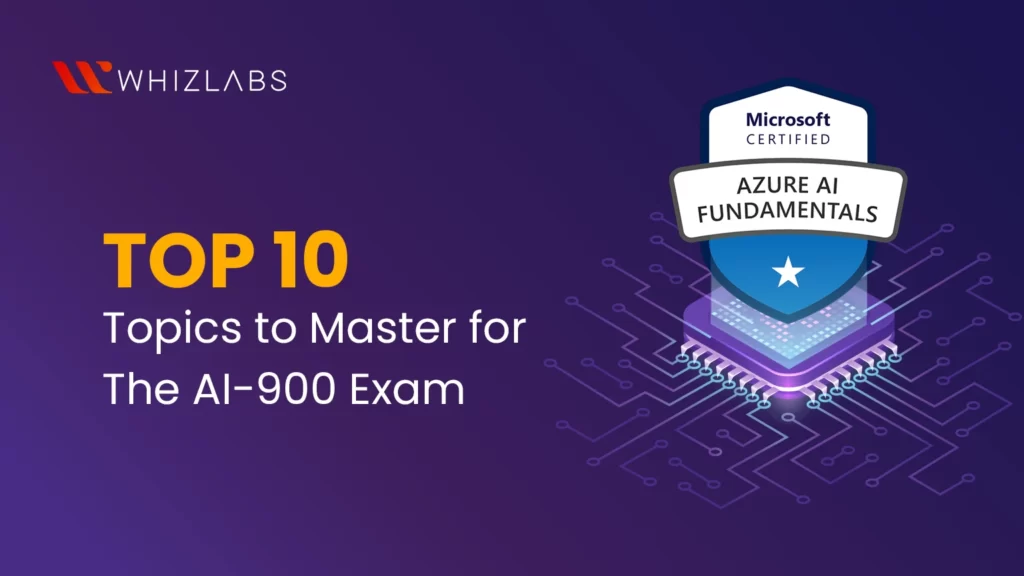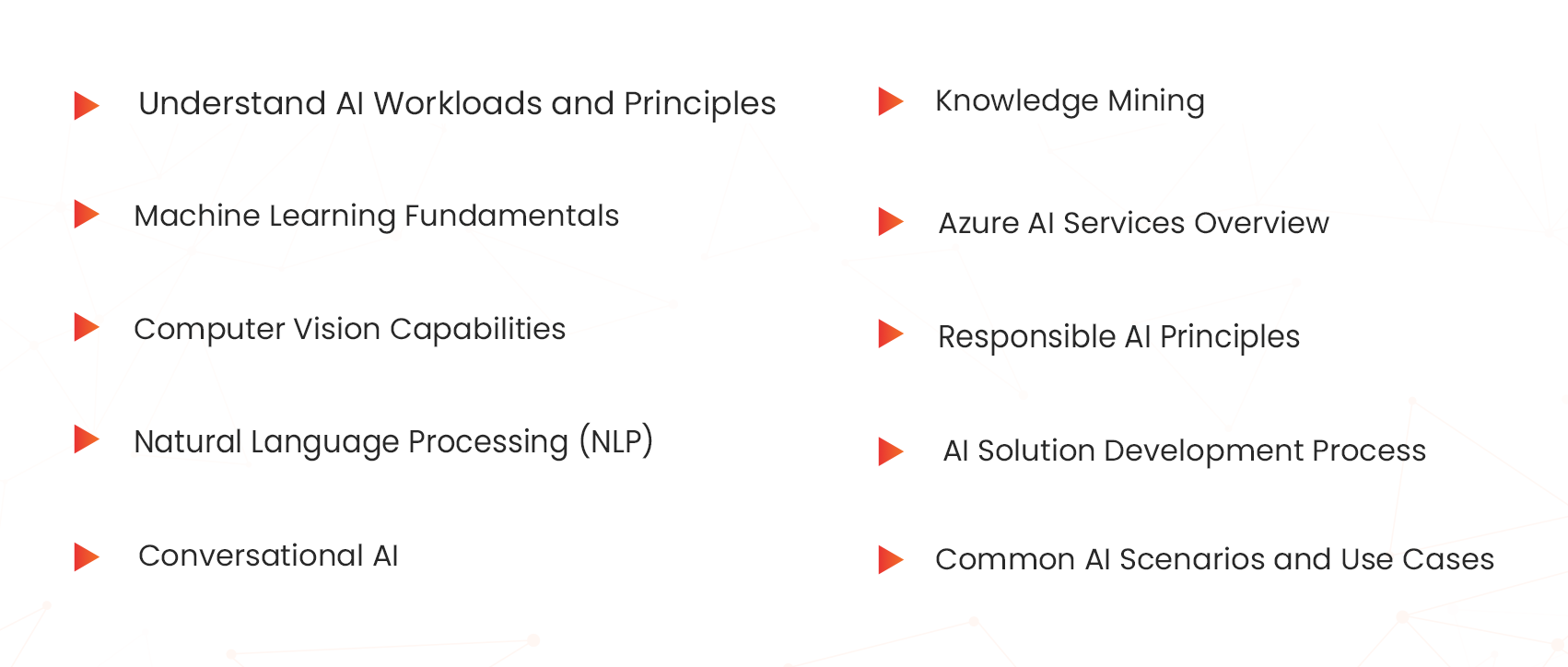In this blog, I am going to deconstruct the top 10 topics you should learn to pass the AI-900: Microsoft Azure AI Fundamentals exam. I will share my personal experiences, relatable insights, and helpful tips so that your preparation process will be enjoyable and entertaining. So, let us jump in!
Why I Chose the AI-900 Exam
I remember the moment when I decided to take the AI-900 examination and was excited, a little but a bit nervous, and did not know where to begin. The world of AI sounds overwhelming, but believe me, the exam is not advanced, and all you have to do is prepare your mind, and you will walk into a test venue (or online examination room) with a lot of confidence.
I am not a data scientist or a machine learning professional, but a person who is interested in AI and the way it is changing the world. I am in IT, and I observed that there was an AI everywhere, be it chatbots or predictive analytics.
I wanted to understand the basics and prove my knowledge with a recognized certification. The AI-900, being a fundamentals-level exam, was perfect for me. No coding is required, just a solid grasp of concepts. If you’re like me, maybe dipping your toes into AI for career growth or curiosity, this exam is your gateway. Now, let’s get to the good stuff: the top 10 topics you need to nail.
1. Understand AI Workloads and Principles
When I first started studying, I was intimidated by the term “AI workloads.” It sounded so technical! But it’s just a fancy way of saying “the different ways AI can be used.”
- For the AI-900, you need to know the core AI workloads like machine learning, computer vision, natural language processing (NLP), conversational AI, and knowledge mining. I found it helpful to think of these as tools in a toolbox. For example, machine learning is like a recipe that learns to improve over time, while computer vision is like teaching a computer to “see” images.
Tip: Focus on what each workload does. For instance, NLP is about understanding text or speech (think Siri or Grammarly).
2. Machine Learning Fundamentals
ML involves training models to predict or make decisions using data.
- Supervised and unsupervised learning
- Training, validation, and testing sets
- Azure Machine Learning: Know that it’s a platform to build, train, and deploy models. You do not need to code, but you need to know such terms as “model,” “training pipeline,” and “endpoint.”
I used the Whizlabs video courses. They explain ML with simple examples, like predicting house prices (supervised) or grouping customers (unsupervised).
3. Computer Vision Capabilities
Computer vision was my favorite topic because it’s so cool, teaching computers to “see”! For the AI-900, you’ll need to know about Azure’s Computer Vision service, which can analyze images for things like objects, text, or faces. I was amazed to learn how it powers apps like self-driving cars or photo-tagging on social media.
Focus on:
Image classification: Labeling an image.
Object detection: It is the recognition and location of objects within an image.
Optical Character Recognition (OCR): Extracting text from images, such as scanning a menu.
Face API: Recognizing faces or faces with emotional or identity recognition (and ethically too!).
I suggest you have hands-on experience(I used the Hands-on labs included in my Whizlabs subscription), as it helped me visualize how these services work. Also, expect scenario-based questions, like “Which service would you use to extract text from a scanned document?”
4. Natural Language Processing (NLP)
NLP is all about making computers understand human language, and it’s a big deal on the AI-900. Think of chatbots, translation apps, or sentiment analysis (figuring out if a tweet is positive or negative). Azure’s Language Service is your go-to for extracting key phrases, sentiment, or entities (such as names or places) out of text for text analytics.
Translation: Changing language between two languages.
Speech services: speaker recognition, Speech-to-text, and text-to-speech
5. Conversational AI
This is where things get fun. Think chatbots! Conversational AI is about creating systems that talk to users naturally, like a virtual customer service agent. Azure’s Bot Service and Q & A Maker (now part of Azure Language) are important.
What to know:
QnA Maker: changes FAQs into a question-answering chatbot.
Bot Framework: a framework to create more advanced bots.
Application scenarios: Customer services, booking applications, or virtual agents.
I imagined designing a chatbot for my favorite coffee shop. How would it handle “What’s the Wi-Fi password?” or “Can you make it quick?” This helped me understand how to structure a bot’s responses. Expect questions on choosing the right tool for a scenario, like QnA Maker for simple FAQs.
6. Knowledge Mining
Knowledge mining was new to me, but it’s about digging insights from unstructured data (like PDFs, emails, or reports) using Azure’s Cognitive Search.
Indexing: Organizing data so it’s searchable.
Skills: Adding AI capabilities like entity recognition or key phrase extraction to searches.
Use cases: Legal document analysis, customer feedback processing, etc.
7. Azure AI Services Overview
The AI-900 loves testing your knowledge of Azure’s AI tools. You don’t need to memorize every detail, but know the big players:
8. Responsible AI Principles
Microsoft holds responsible AI as important, and so is the AI-900. The six principles are
I related these to real life. For example, fairness is like ensuring a job application AI doesn’t favor one group over another. Expect scenario questions, like “How would you ensure an AI hiring tool is fair?”
9. AI Solution Development Process
This subject is regarding the process of developing an AI solution, from the identification of the problem to the delivery of the model. This seemed to me like a recipe: get ingredients (data), mix (train), bake (deploy), and serve (monitor).
Find the problem: What is it you are solving?
Clean data: clean and arrange information.
Train the model: employs Azure tools such as ML Studio.
Test and implement: Test the model and release it.
Monitor: Watch performance.
This is what I imagined as planning a road trip: setting a destination, packing supplies, driving, and inspecting the car.
10. Common AI Scenarios and Use Cases
The AI-900 loves throwing scenario-based questions at you, like “Which Azure service would a retailer use to predict sales?” You need to match AI workloads to real-world problems.
Retail: Predict demand using ML, and analyze customer reviews with NLP.
Healthcare: Detect diseases with computer vision, and transcribe doctor notes with speech services.
Customer Service: Build chatbots with Bot Service.
My Study Strategy: What worked and what did not
When I started preparing, I gave myself six weeks (2 productive weeks), studying 1–2 hours a day. Here’s what worked for me:
Microsoft Learn: Their free AI-900 learning path is gold. It’s interactive and covers all topics.
Practice Tests: I used Whizlabs. They mimic the real test’s scenario-based questions. Don’t miss this.
Hands-On Labs: I played with the AI services, did not break my bank, and had the hands-on labs and Sandbox combo from Whizlabs again.
Flashcards and Notes: I used Anki for key terms and a notebook for scenarios, Copilot to be a study buddy, and I watched a couple of YouTube videos to revise, and finally went through the cheatsheet.
One thing I learned: don’t cram everything. Focus on understanding, not memorizing. The exam is multiple-choice, with about 40–60 questions, and you have 60 minutes. I finished with time to spare by practicing time management. Know more about my AI-900 preparation with a quick read.
Wrapping Up: You’ve Got This!
I went from feeling intimidated to confidently explaining AI concepts. By learning these top 10 topics: AI workloads, machine learning, computer vision, NLP, conversational AI, knowledge mining, Azure services, responsible AI, solution development, and use cases, you’ll be ready to ace the exam. Apply the concepts to real life, use Whizlabs and Microsoft Learn, and scenario practice. Any questions, or would you like to share your prep journey? Drop a comment, and I would love to read about it. Good luck!
- Tableau Data Analyst Salary and Job Trends 2025 - September 30, 2025
- Ultimate Java SE 21 1Z0-830 Preparation Guide for Beginners - September 30, 2025
- Best AWS Certification Courses in 2025 - August 22, 2025
- How to Pass the NVIDIA NCP-ADS Exam in 2025 - July 15, 2025
- Top 10 Topics to Master for the AI-900 Exam - July 10, 2025
- SC-401 Prep Guide: Become a Security Admin - June 28, 2025
- How Does AWS ML Associate Help Cloud Engineers Grow? - June 27, 2025
- Top 15 Must-Knows for AWS Solutions Architect Associate Exam - June 24, 2025




